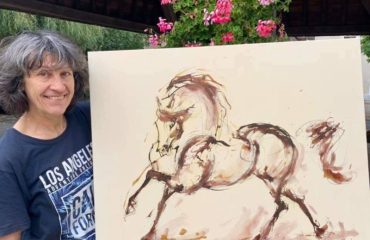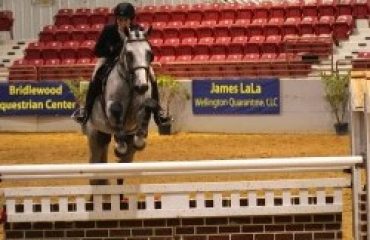
Boyd Martin riding Gloria Callen’s mare Welcome Shadow
Photo by Amber Heintzberger
Well known for both his fun-loving approach to life and his indefatigable work ethic, Boyd Martin has represented the U.S.A. in three-day eventing at two Olympic Games and two World Championships, and was on the gold-medal-winning Pan Am Games team in 2015. Boyd’s wife, Silva Martin, is a grand prix dressage rider and they have a son, Nox. Boyd and Silva train out of their own farm, Windurra USA in Cochranville, Pennsylvania, and spend winters at Stable View Farm in Aiken, South Carolina.
What must-have items do you always keep in your trailer?
My head groom, Sidney Baughman, is the master of organization and preparedness. Sid said that her trailer tack room must-haves include: “An extra halter or two, a Trailer Aid tire changing block, veterinary equipment box equipped with sedation and Banamine — sick horses and accidents are never expected, but you should always be prepared for the worst. Buckets and a jug of water, even if it’s meant to be a short trip; again, you want to be prepared in case of a breakdown or traffic delay, especially on a hot day. I always keep a set of bandages handy, hoof packing stuff, and the show trunk equipped with all of Boyd’s needs (helmets, boots, spurs, etc…), extra bridles and bits for all phases, saddle pads and a trailer-specific box of grooming equipment.”
I want to be a working student, do you have any advice?
We are once again searching for a working student, and we’ve had a few applicants express interest but after chatting with Sid about the job requirements, they tend to drift on to the next, possibly easier, opportunity. I recognize that not everyone is looking to become the next Mark Todd or Michael Jung, but if you are interested in improving your riding and learning the ropes of the horse industry, maybe even becoming a professional one day, there is no better way than immersing yourself in the day-to-day activities of a successful competition barn. Admittedly, the work is hard, but if you are willing to invest the time and energy, you will reap the benefits. A number of my working students have really dedicated themselves to the job and after several years of work under my guidance, they have gone out on their own as professional event riders and trainers. It may look glamorous when they are cantering down the centerline in the big stadium at Rolex Kentucky, but they have put in a lot of dirty, sweaty, hard work behind the scenes to get there. I would encourage anyone who takes their riding seriously to do the same.
What are some suggestions to practice setting your horse up for cross-country fences?
One of the abilities we need to work on is jumping fences out of stride. The only way to develop your eye and see a forward three strides is to practice. I put rails on the ground around my arena and practice cantering them with minimal adjustments. Even if you make a mistake over a rail, there are no big consequences, like with a big solid fence. I try to see the stride as I use the rails and this creates a bit of confidence in myself, and I believe the horse starts to trust the rider too, so that when you see a distance, the horse also believes it’s a good decision.
Do you think the long format should make a comeback at the lower levels, and do you think it would reduce accidents and injuries in the long run?
To be honest, I think we’re in a new era of eventing where we’re seeing a lot of different forms of the sport. I’m a fan of the long format because that’s what I grew up with in Australia. I’m also having a lot of fun with arena eventing, and the long format at training level is really thriving here in the United States. I think the FEI level without steeplechase is here to stay. To be a complete event rider, I’d say you need to master the art of riding a long-format three-day event because the training, fitness and preparation is different. If my kid ever decides to take up eventing, I’ll be encouraging him to participate in the long format.
Do you think clinics are a worthwhile addition to training?
This time of year, I’m teaching a lot of clinics. I also participate in a lot of clinics myself; a couple weeks ago I rode in a Joe Fargis clinic. The key is simple: The coach is going to give you a message of what works for them. It’s probably not exactly the same as what your coach says, but for the two-hour session, suck it up and throw yourself into the message the coach is trying to teach. When you hop in your car on the way home, think about what you learned, consider what you liked, and don’t be afraid to throw out what didn’t work for you — that way we all come up with our own style of riding. I always like to take these bits and pieces and try them with some of my horses. You need to be open-minded and take it all in; the clinician’s system has worked for them, so it’s not a bad idea for you to try imitating bits and pieces of it.













